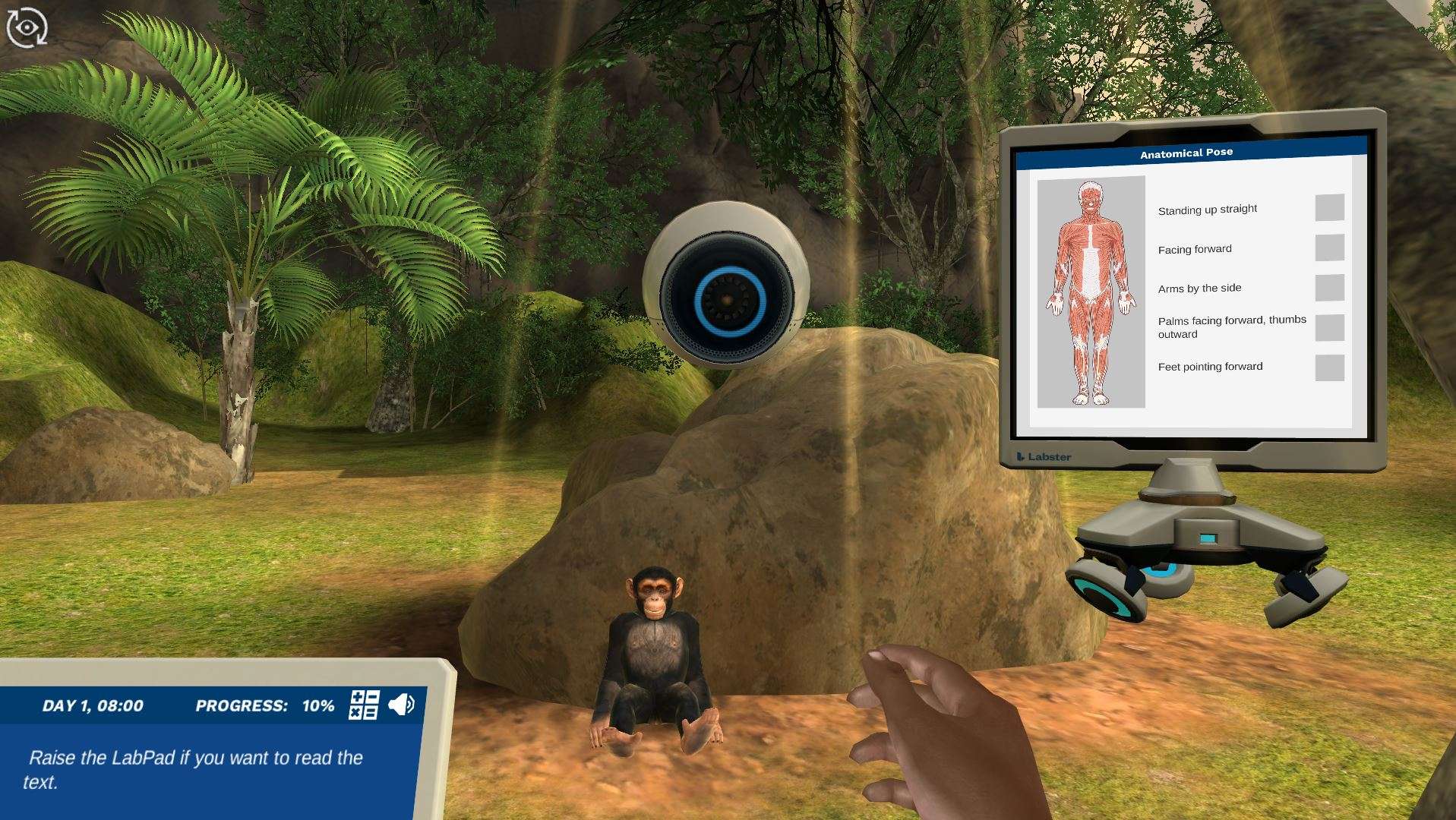Heading 1
Heading 2
Heading 3
Heading 4
Heading 5
Heading 6
Lorem ipsum dolor sit amet, consectetur adipiscing elit, sed do eiusmod tempor incididunt ut labore et dolore magna aliqua. Ut enim ad minim veniam, quis nostrud exercitation ullamco laboris nisi ut aliquip ex ea commodo consequat. Duis aute irure dolor in reprehenderit in voluptate velit esse cillum dolore eu fugiat nulla pariatur.
Block quote
Ordered list
- Item 1
- Item 2
- Item 3
Unordered list
- Item A
- Item B
- Item C
Bold text
Emphasis
Superscript
Subscript
About This Simulation
In this virtual lab you will help release an injured chimpanzee back into the wild by using your newfound knowledge of body planes and sections.
Learning Objectives
- Describe the anatomical position
- Identify the anatomical reference planes
- Describe the human body using directional and regional terms
About This Simulation
Lab Techniques
Related Standards
- Early Stage Bachelors Level
- EHEA Second Cycle
- EHEA First Cycle
- FHEQ 6
- SCQF 10
- SCQF 9
- US College Year 2
- US College Year 1
Learn More About This Simulation
Help us release an injured chimpanzee back into the wild! In this simulation, you will be introduced to the anatomical position as well as body sections and planes using a chimpanzee as a model. Apply body planes to scan regions and subregions of the chimpanzee’s body to locate internal injuries. Next, use directional terminology to identify and patch up external wounds. Finally, boost the chimp’s energy level by using your new knowledge to win virtual fruit in a trivia game.
Assemble a chimpanzee model
Piece together a chimpanzee model with regional and sub-regional puzzle pieces using human anatomy as reference. Take scans in the correct body planes to examine internal injuries in the sub-regions of the chimpanzee.
Pinpoint the location of injuries
Learn the definitions of directional terms to be able to explain the location of the chimpanzee’s superficial and internal injuries. Look at scans of different subregions to decide if the chimp needs further medical care. Then fix up the superficial wounds the chimp has suffered.
It’s trivia time!
Test your knowledge while filling up a fruit basket for the chimpanzee. A set of trivia questions will assess your newly gained knowledge on the anatomical position, body planes and sections, regional and sub-regional terms as well as directional terminology. How many pieces of fruit can you collect for the chimp?
For Science Programs Providing a Learning Advantage
Boost STEM Pass Rates
Boost Learning with Fun
75% of students show high engagement and improved grades with Labster
Discover Simulations That Match Your Syllabus
Easily bolster your learning objectives with relevant, interactive content
Place Students in the Shoes of Real Scientists
Practice a lab procedure or visualize theory through narrative-driven scenarios


FAQs
Find answers to frequently asked questions.
Heading 1
Heading 2
Heading 3
Heading 4
Heading 5
Heading 6
Lorem ipsum dolor sit amet, consectetur adipiscing elit, sed do eiusmod tempor incididunt ut labore et dolore magna aliqua. Ut enim ad minim veniam, quis nostrud exercitation ullamco laboris nisi ut aliquip ex ea commodo consequat. Duis aute irure dolor in reprehenderit in voluptate velit esse cillum dolore eu fugiat nulla pariatur.
Block quote
Ordered list
- Item 1
- Item 2
- Item 3
Unordered list
- Item A
- Item B
- Item C
Bold text
Emphasis
Superscript
Subscript
A Labster virtual lab is an interactive, multimedia assignment that students access right from their computers. Many Labster virtual labs prepare students for success in college by introducing foundational knowledge using multimedia visualizations that make it easier to understand complex concepts. Other Labster virtual labs prepare learners for careers in STEM labs by giving them realistic practice on lab techniques and procedures.
Labster’s virtual lab simulations are created by scientists and designed to maximize engagement and interactivity. Unlike watching a video or reading a textbook, Labster virtual labs are interactive. To make progress, students must think critically and solve a real-world problem. We believe that learning by doing makes STEM stick.
Yes, Labster is compatible with all major LMS (Learning Management Systems) including Blackboard, Canvas, D2L, Moodle, and many others. Students can access Labster like any other assignment. If your institution does not choose an LMS integration, students will log into Labster’s Course Manager once they have an account created. Your institution will decide which is the best access method.
Labster is available for purchase by instructors, faculty, and administrators at education institutions. Purchasing our starter package, Labster Explorer, can be done using a credit card if you are located in the USA, Canada, or Mexico. If you are outside of North America or are choosing a higher plan, please speak with a Labster sales representative. Compare plans.
Labster supports a wide range of STEM courses at the high school, college, and university level across fields in biology, chemistry, physics, and health sciences. You can identify topics for your courses by searching our Content Catalog.















